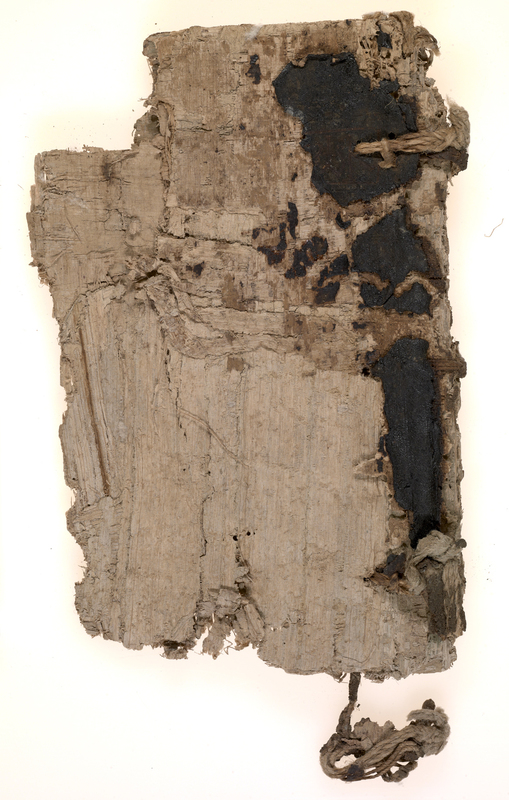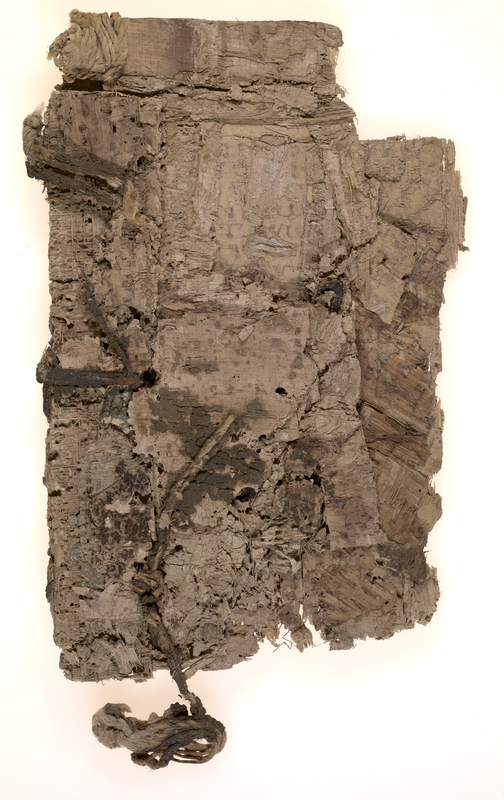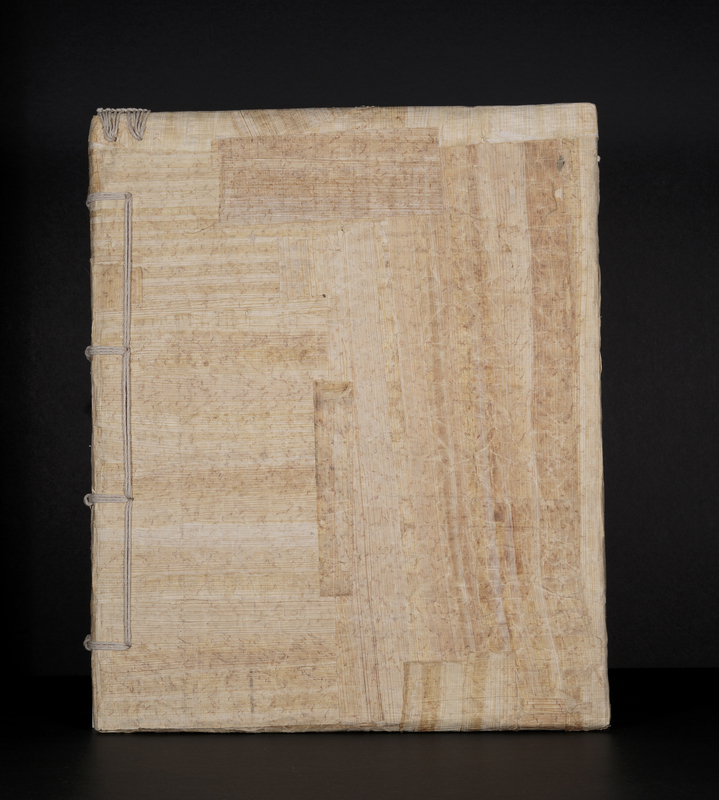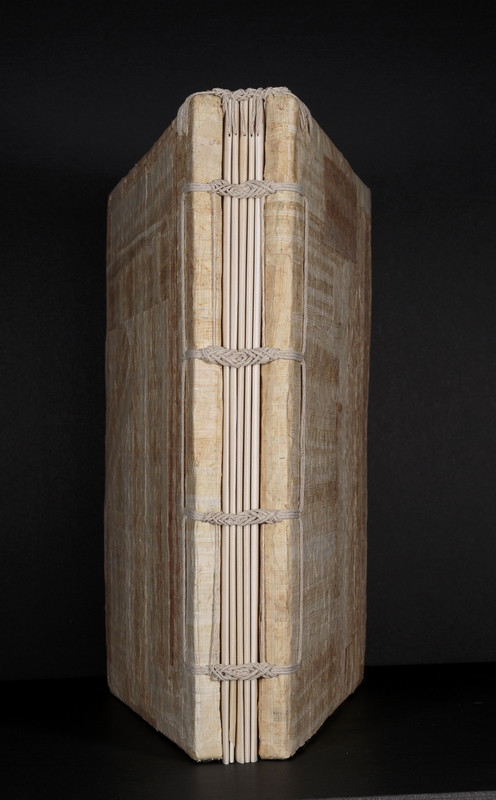A Board Fragment with Structural Elements
P. Mich. Inv. 7077
A partial book board with most of the leather cover missing but with much of the coarse vegetable-fiber cord that was used to form its bridles still in place (bridles are passes of thread wrapped on the edge of book boards to serve as catch points for sewing thread that would attach a sewn text block to the book boards before the leather covering was added). One edge of the board retains its endband tie-downs; this survival tells us this is a top or bottom edge, and helps us measure the original height of the board. There are two fairly intact bridle stations visible on the cover and a third, where the cord lacing has been cut away but is still partially present. The cord bundle that extends beyond the edge of the board is the fourth and final bridle. It is the survival of this fourth bridle and its extension, plus the height of the board from the first bridle to the edge with endband tie-downs, that allows us to estimate the original height of the board (approximately 35 cm high). Note that since bridles were added to a board before the leather covering was attached the top bridle on this fragment sitting on top of the leather is a repair; the original bridle is just visible beneath the leather.
P. Mich. Inv. 7077 (verso)
This is a view inside 7077. The photo shows the patchwork nature of the cartonnage and the different qualities of the papyrus used; the cartonnage includes inscribed papyri and also a strip of leather, slit for decorative lacing, just below the second bridle.
A recent examination of 7077 by participants in the 2016 Papyrology Institute at the University of Michigan Library resulted in important new information concerning the bridled board fragment. Lorenzo Uggetti, a PhD candidate in Demotic & Greek Papyrology at the École Pratique des Hautes Études in Paris noticed that not just one of the board bridles was repaired with added thread wraps; two others, the third and fourth bridles, now very damaged and cut free of the board, also show evidence of the same repair. This speaks not only to ancient repair techniques, but also to the very important fact that examination of materials by different scholars often yields more information.
Cartonnage fragments assigned to P. Mich. Inv. 7077
Here is a box containing other cartonnage fragments assigned to 7077. A team composed of a papyrologist and a conservator may be able to piece these fragments back together someday.
Model of P. Mich. Inv. 7077 (upper cover)
This is a model of what P. Mich. Inv. 7077 may have looked like when intact; these "papyrus cartonnage" boards measure 35 x 30 cm. The boards are bridled with thread in the same style as the fragment. Text gatherings have been wrapped with parchment to suggest the original text-block material and sewn in link unsupported style. The sewn text block is attached to the bridles by extensions of the sewing thread on each side. These extensions are laced through the bridle corresponding to that sewing station, back through the sewing, back around the bridle, and then proceeding along the board edge to the next bridle-sewing station until all bridles and sewing stations are connected on both boards. An endband anchored in the boards and worked across the top of the book illustrates what the endband tie-downs visible on 7077 fragment suggest to us.
Model of P. Mich. Inv. 7077 (spine)
These extensions of sewing are laced through the bridle corresponding to that sewing station, back through the sewing, back around the bridle, and then proceeding along the board edge to the next bridle-sewing station until all bridles and sewing stations are connected on both boards. An endband anchored in the boards and worked across the top of the book illustrates what the endband tie-downs visible on 7077 fragment suggest to us.
Model of Morgan 599 (lower cover)
Here is a model of a late-Coptic binding, Morgan 599, to illustrate the types of decoration found on these large service books. Unfortunately, there is not enough leather surviving from the 7077 board fragment to be able to tell what style of decoration was used on the cover, aside from border lines.
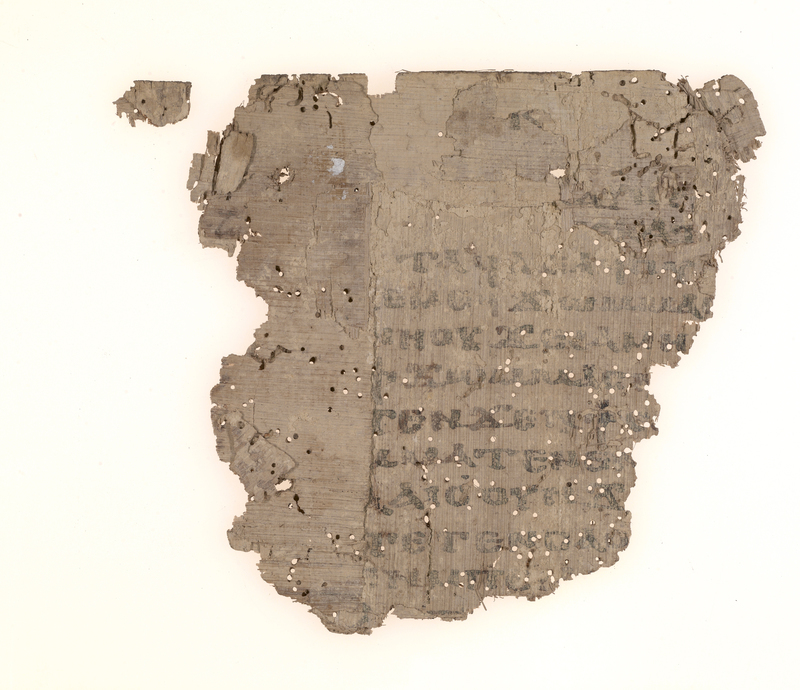
Cartonnage & Decorated Leather Cover Fragments

More Text Evidence of Binding

